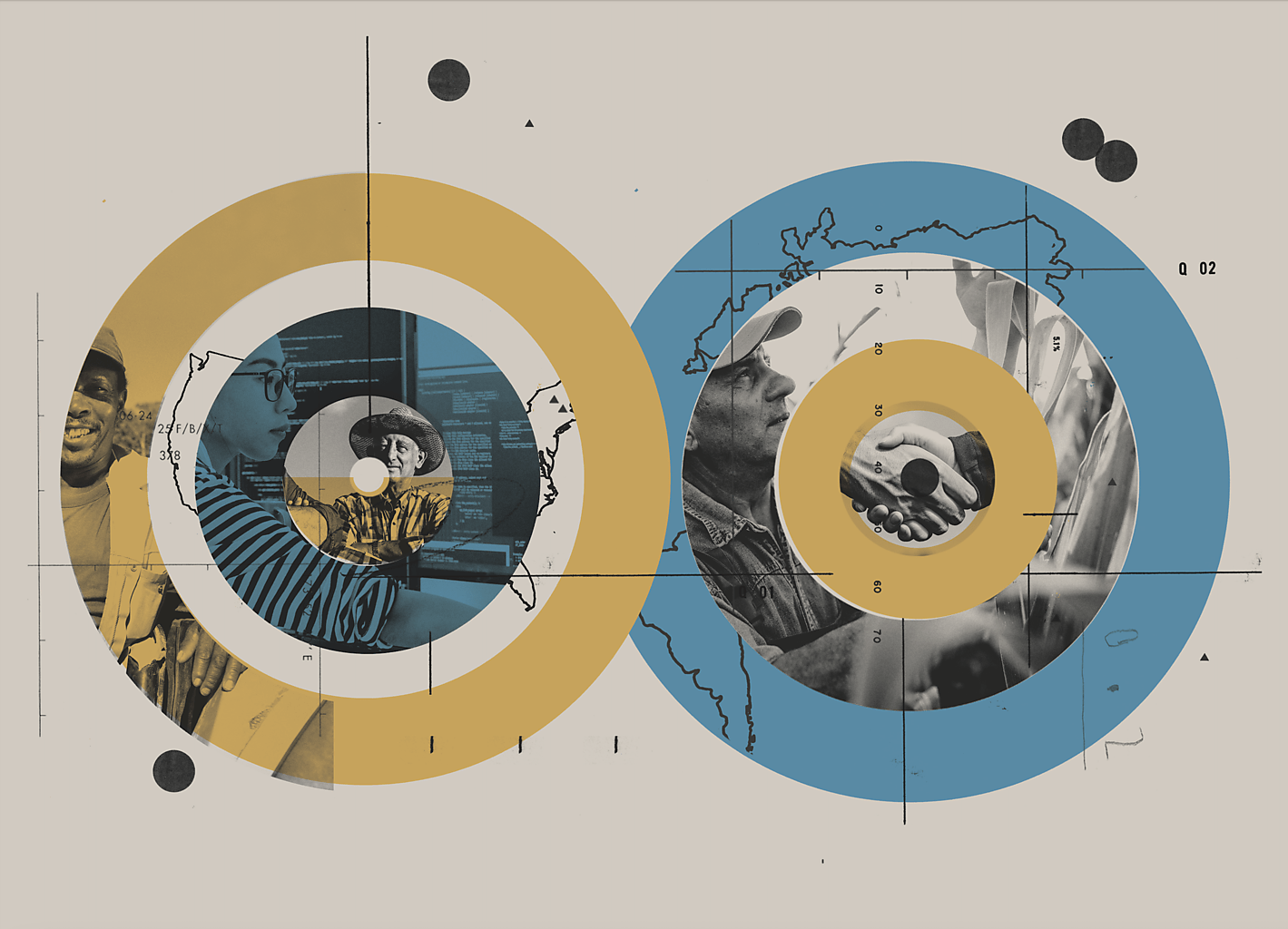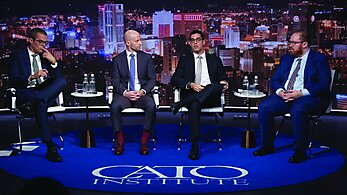Illustrations by Mike McQuade
Globalization Is about People, Not Governments
Populist calls for the “death of globalization” ignore not only the practical and moral benefits of open markets but also their fundamental humanity.
bit of advice: When politicians and pundits attack “globalization,” look less at what they’re saying and more at what they aren’t.
According to former President Donald Trump, “Globalization has made the financial elites who donate to politicians very wealthy, but it’s left millions and millions of our workers with nothing but poverty and heartache—and our towns and cities with empty factories and plants.” The Biden administration is pushing for a “new economic order,” with US Trade Representative Katherine Tai asserting that governments’ urge “to liberalize as much as possible” has led to a “race to the bottom.”
Sen. J. D. Vance (R‑OH) claims that “the effects of globalization have hollowed out America’s industrial core.” Not to be outdone, Sen. Bernie Sanders (I‑VT) charges that an “increasingly globalized economy, established and maintained by the world’s economic elite, is failing people everywhere.”
Whether right or left, the critics follow the same general narrative. First, globalization has been an economic disaster. It has “deindustrialized” America, hollowed out the middle class, destroyed most industrial communities, created a race to the bottom benefiting rootless corporations at workers’ and the environment’s expense, unleashed waves of migrants and geopolitical instability, and fueled the unstoppable rise of authoritarian regimes.
Second, the carpers treat globalization as some kind of free-market religion practiced by elite policymakers, as though guys like Milton Friedman and Larry Summers cooked it up in a 1990s lab somewhere—probably Davos—and then used secretive trade agreements to unleash it upon the helpless and unwitting working-class masses here and abroad. Only a rigid adherence to “fundamentalist” ideology and desire to maintain corporatist power, not economics or history or simply pragmatism, explain why a few holdout elites continue to support globalization today.
If these claims sound familiar, they should—it’s almost exactly what previous anti-globalization groups peddled in decades past. Yet this time around the arguments aren’t just on the fringes of the left and right; they’re increasingly found in the media, in corporate boardrooms, and on the campaign trail. In both words and deeds, Donald Trump and Joe Biden are often following the same protectionist script.
Like their predecessors, however, today’s hysterics over global trade get far more wrong than right and ignore far too much. They butcher economic principles (and basic facts) and fundamentally misunderstand that, far from being a modern creation of government or corporate elites, globalization is just ordinary people working, interacting, bargaining, buying, and selling as they’ve done for millennia—all in ways that just so happen to cross political borders. Government policy can make these actions easier, mainly by eliminating past government barriers, as can new technologies like the shipping container or internet. But the actions remain undertaken by billions of humans seeking better lives for themselves, their families, and their communities every day. There is no on or off switch for a politician to flip.
The Faces of Globalization
Cato Institute distinguished scholar Deirdre McCloskey knows more about globalization—the real globalization—than just about anyone on the planet, and she explains that it’s a “common term that’s commonly misunderstood.”
“It is the gradual convergence of prices and markets that results from humans freely doing what they have done throughout history—work, innovate, and transact for mutual benefit,” McCloskey elaborates. “It’s merely the gradual emergence in our world of a single economy.”
Put simply, as nations have become freer over time and technology has brought us closer together, our inherent drive for “mutual benefit” has generated an economy where people can buy and sell globally. How freely and efficiently this occurs depends on the economic liberty of each country involved. In general, the greater the economic freedom, the more globalization. (The 2023 Economic Freedom of the World report places Singapore in the number-one spot, followed by Switzerland, New Zealand, the United States, Ireland, Denmark, Australia, the United Kingdom, and Canada.)
Humans are unique in our ability to peacefully exchange goods to meet our needs and improve our lives. As Adam Smith told us in The Wealth of Nations—“Man is an animal that bargains.” Globalization, therefore, is primarily a story about humanity, not soulless multinational corporations or faceless political regimes.
One of those people is Laboni, a 30-year-old woman who lives in Gazipur, Bangladesh, one of the country’s industrial centers. Her family’s economic condition was “miserable” growing up, as her father could not find regular employment as a farmworker and often couldn’t afford to buy food for his family, she told Free Society. Seeking a better life, she moved to Gazipur in 2015 and landed a job at an international garment factory, where she was trained as a sewing machine operator.
“I have no idea what I would be doing if I didn’t have this job,” said Laboni, who requested only her first name be used. “After getting a job with a garment factory, my life became secure. I can meet all my expenses like food, clothes, shelter and can buy other things. Now we can live well. I have one son, and I can send him to school, buy necessary things for him.”
Globalization goes far beyond textiles, of course, with different cultural norms, ideas, and even culinary traditions stretching across continents.
Take Pakistan, which is hungry for everything from American fast food to the Philly cheesesteak. The Philadelphia Inquirer recently profiled how a Pakistani chef learned of cheesesteaks from a Philadelphia traveler in 2021. Impressed by the meat and cheese concoction, he decided to open Philly’s Steak Sandwich in Lahore, featuring the famous sandwich with a twist of red chili powder, tikka masala spices, and other local flavors.
Here in the United States, meanwhile, millions of people are employed by foreign companies that have invested trillions of dollars in the American economy in recent decades.
John Hall, who works in the engine-assembly department at the Korean-owned Hyundai Motor Manufacturing plant in Alabama, testified before the Commerce Department in 2018 about how proposed protectionist policies would hurt Americans like him.
“I’ve also seen how global trade is key to Hyundai’s American manufacturing operations and workers,” Hall told officials. “We at Hyundai believe strongly that automotive imports do not threaten our national security. In fact, it’s just the opposite. Imports and exports are essential to our business and the growth of the American automotive industrial base and a skilled workforce.”
Other Americans are embracing new technologies that enable them to buy and sell digital services in real time from anywhere in the world, opening new possibilities for video streaming, remote work, and other modern trends. Dallas business owner Chris Koerner, for example, hired a PhD mathematician in Pakistan last year to tutor his 12-year-old son, who was having trouble with algebra, the Wall Street Journal reported.
Governments, of course, also play a role. Reducing tariffs and other protectionist measures, often via trade agreements like the World Trade Organization and the North American Free Trade Agreement, has undoubtedly helped economic freedom to spread. But trade barriers must first be imposed before they can be eliminated. Modern trade liberalization is therefore best understood as governments simply ceasing to interfere in natural, human-led commerce.
Globalization, like any market phenomenon, is imperfect and often disruptive. People will lose jobs, but people will gain jobs; entire industries will die, but entire new worlds of employment and opportunity will open. The exact path cannot be predicted, let alone managed by government bureaucrats with an “industrial policy,” but the general direction can: Things will get better.
Indeed, the movement of goods, services, people, capital, and ideas across natural or political borders has unquestionably produced immeasurable benefits—for the United States and the world—that no other system can match. The World Bank estimates, for example, that since 1990 more than a billion people have been lifted out of extreme poverty, in large part thanks to the rising tide of globalization.
In other words, thanks to their fellow humans.
The Places of Globalization
Older industrial cities across the nation, especially in the Midwest, are frequently held up as victims of globalization. There is perhaps no better example of this than Youngstown, Ohio, a once-powerful steel town that saw its population fall from 169,000 in 1950 to about 59,000 today, a precipitous decline often attributed to the closure of steel mills in the 1970s and ’80s due to foreign competition.
“I saw the city shrink,” Vince Guerrieri, a Cleveland-based journalist who grew up in Youngstown during the ’70s and ’80s, told Free Society. “Things were changing everywhere.”
Youngstown’s steel mills used older, open-hearth furnaces that could not compete with the newer basic oxygen furnaces (BOFs) common in Japan, South Korea, Germany, and other nations. What took eight hours to make in the US furnaces could be done in the BOFs “in about an hour and a half,” Lou DeSimone, a former salesman at Youngstown Sheet and Tube, told Guerrieri in an interview. That efficiency means lower production costs, which in turn enabled foreign steel companies to sell in the United States at prices Youngstown’s factories couldn’t match.

Extreme poverty, child labor, and inequality in well-being have all fallen since 2000

World Bank Poverty and Inequality Platform, “Number of People Living in Extreme Poverty, 1974 to 2019,” Our World in Data; “Child Labour: Global Estimates 2020, Trends, and the Road Forward,” International Labour Organization and United Nations Children’s Fund, 2021, p. 23; and Chelsea Follett and Vincent Geloso, “Global Inequality in Well-Being Has Decreased across Many Dimensions,” Cato Institute Policy Analysis no. 949, June 8, 2023.
Such competition surely hurt Youngstown companies and workers, but the story—for the town and others like it—doesn’t end there. First, US steelmakers wedded to open-hearth furnaces also faced intense competition during the 1980s from interstate rivals, particularly ones in the South that used nonunion labor and BOFs or electric arc furnaces (EAFs), which were even more efficient. Today, Charlotte-based Nucor, which pioneered EAFs in the United States, is the nation’s largest steelmaker. We ignore the competitive effects of this “cross-border” competition, whether for steel or any other industry, but it’s no less real.
Second, the lower steel prices that hurt Youngstown, whether from Nucor or foreign firms, provided substantial benefits to other American towns that were home to companies that used steel—manufacturers that today employ about 70 times as many American workers as do US steelmakers. This increased efficiency is one of the most important aspects of globalization (and interstate competition), which again extend beyond steelmaking.
Third, we must ask what industrial cities in the United States did after disruption arrived there. Indeed, while Youngstown struggled to adapt to an increasingly interconnected world, other towns and cities throughout the United States once reliant on bygone industries have evolved into diversified, dynamic local economies—thanks in large part to globalization.
A 2018 study by the Brookings Institution examined the economic evolution of 185 old industrial US counties that had a disproportionate share of manufacturing jobs in 1970, finding that 115 had successfully transitioned from their reliance on manufacturing, based on a composite measure of current gross domestic product (GDP), per capita income, and unemployment rates. Of the 70 counties that had not successfully transitioned, 40 showed “strong” or “emerging” economic trends. Only 30, or about 16 percent, of those “struggling 1970s mill towns” we read so much about were still struggling a decade ago.
For the places that moved on, the route each took depended on its unique resources, skills, and circumstances, but the one thing they all had in common is that they adapted in the face of disruption, whether from globalization or other factors. And usually it was for the better.
Consider Greenville, South Carolina, which sits between Charlotte and Atlanta along I‑85 and was once known as the “Textile Capital of the World,” with mills employing thousands of breadwinners. As the textile industry’s employment opportunities began cratering due to technological innovation and foreign competition in the 1970s, Greenville’s future was at risk.
However, other multinational companies filled the void, attracted to the area’s skilled workforce and business-friendly environment. The French tire manufacturer Michelin started manufacturing in Greenville in 1975 before eventually building its North American headquarters there. BMW built its first full assembly plant outside Germany near Greenville in 1992, a facility that has since been expanded multiple times. Other advanced manufacturers have also set up shop in the area, along with high-skill services like banking and tech. Several of those long-vacant textile mills have been transformed into residential lofts, housing the workers that make up Greenville’s dynamic and revitalized economy today.
A similar story played out in Tuscaloosa, Alabama, which was also hit hard by the offshoring of the textile industry through the 1990s.
“Alabama, like many Southeastern states, was beginning to lose thousands of jobs—in our case ultimately tens of thousands of jobs—in traditional manufacturing sectors such as textiles and apparel,” Steve Sewell, executive vice president of the Economic Development Partnership in Alabama, told Free Society. “Our apparel industry was decimated. Those industries had been so important to communities throughout the state for decades.”
But in 1993, Mercedes-Benz decided to build its first passenger car manufacturing plant outside Germany in Tuscaloosa, bringing with it first-class manufacturing standards, high-tech assembly lines and automation, superb automobiles, and high-paying jobs. After Mercedes, four other global carmakers and their suppliers have moved to the state over the past 25 years: Honda, Hyundai, Mazda, and Toyota. These companies comprise Alabama’s five largest employers, with 47,000 workers on the payrolls in 2023, according to the Alabama Department of Labor. About one in six Alabamians in the manufacturing sector work in the auto industry, reported Alabama Arise. Those automobiles, engines, and parts are all built in the United States by American workers and sold to Americans nationwide and to people in 135 other countries.
Overall, the influx of advanced manufacturing has “had a ripple effect all the way through the economy,” said Donny Jones, the chief operating officer for the Chamber of Commerce of West Alabama.
“It’s contributed to the University of Alabama’s growth, the growth of our small businesses, the whole ecosystem. It’s had a huge impact,” Jones said.
Foreign automakers were drawn to the Southeast for the region’s low taxes, relaxed regulatory environment, and right-to-work laws. Some Southern states, including Alabama, also offered incentive packages to encourage foreign manufacturers to pick their localities over neighboring jurisdictions, but the investments were going to happen in the region regardless of the subsidies.
The evolution of these places and dozens of other US industrial cities raises two uncomfortable truths for today’s anti-globalization critics. First, government efforts to “protect” Youngstown’s steel jobs with tariffs or other measures that inflate US steel prices would hurt the many other American towns that are home to steel-consuming companies—towns like Greenville and Tuscaloosa. Second, the problem facing Youngstown and the handful of other struggling communities wasn’t import competition but their inability to adjust to seismic economic changes. That issue is worth exploring but surely doesn’t involve demonizing “global elites.”
Our increasingly interconnected world has also given rise to new powerhouse centers of commerce and culture—a vast and thriving America away from old manufacturing towns.
Laredo’s population has doubled over the past three decades, spurred by the signing of the North American Free Trade Agreement in 1994, which lifted most barriers to trade and investment between Mexico, the United States, and Canada.
“Laredo pivoted and started growing substantially,” said Ignacio Urrabazo, a longtime Laredo resident and bank executive. “Restaurants, all the hospitals are looking for doctors. Clinics are opening up. The schools are growing; they’re recruiting teachers. All of that, the multiplier effect down the line affects all sectors of the economy.”
In effect, the government got out of people’s way, creating a freer environment for them to bargain, trade, and prosper, and Laredo thrived. Many other American cities have done the same.
As the world gets more intertwined, other nations are free to lean into their own comparative advantages, producing whatever goods, services, and ideas that best align with their own unique resources and skills.
Back in Bangladesh, a place that has long been one of the poorest places on the planet has experienced several decades of expanded trade (especially in textiles and apparel), strong economic growth, and dramatic declines in poverty.
As Bangladesh has traded more with the world, a greater share of its population has escaped poverty—from slightly more than 40 percent in poverty in 1983 to only about 14 percent in 2017. This happened because of globalization.
“After having acquired outside know-how and machinery in the 1980s, local entrepreneurs quickly turned the country into a global powerhouse for textile manufacturing,” Cato senior fellow Johan Norberg explains. “Before 1980, [Bangladesh] did not have any factories that produced textiles and garments for exports; today, the sector contributes more than 13 percent of GDP and 80 percent of exports. This has created millions of jobs, especially for women. The economy has grown rapidly, and according to the World Bank, extreme poverty has been reduced from over 40 percent in 1991 to less than 14 percent in 2016.”
The Cases for Globalization
Trump claims globalization has left “millions and millions of our workers with nothing but poverty and heartache,” while Biden claims that the “middle class and thriving towns across America” have been “hollowed out” in recent decades. Other critics point to widespread poverty and environmental degradation, again blaming trade and migration.
That’s simply not the case. Total US manufacturing employment has indeed declined in recent decades, but the US economy has gained tens of millions of nonmanufacturing jobs (many of them owed to foreign investment, imports, and other aspects of globalization). Since “hyperglobalization” began in the 1990s, moreover, the median American worker’s inflation-adjusted pay has risen by around 40 percent.

Laboni (right), a 30-year-old sewing machine operator in Gazipur, Bangladesh, said the boom in textile manufacturing improved her family’s life: “Now we can live well.”
America’s middle class, which refers to households making $35,000 to $99,999 a year, did drop from 52.9 percent in 1970 to 39 percent in 2021, but those Americans leaving the middle class were usually climbing up the economic ladder, not falling down it. Upper-class Americans making $100,000 a year or more went from 15.8 percent of the population in 1970 to 35.8 percent in 2021. The share of low-income Americans making $34,999 or less, meanwhile, dropped from 31.4 percent to 25.2 percent in that same time frame, according to Census Bureau data. In short, we’ve replaced poor and middle-class American households with wealthier ones.
America’s industrial base also hasn’t been “shipped overseas.”
It is true that certain manufacturing industries—particularly labor-intensive, low-tech ones, such as textiles and apparel—have shrunk or are no longer located in the United States. But many other industries, with higher added value, have flourished, while manufacturing remains a vital part of the country’s economic base and a major global player.
The manufacturing sector has lost jobs since the 1970s, but that was largely driven by an increase in labor productivity and technological advances, such as robots, automation, computers, and process improvements. (According to one 2015 study, productivity growth was responsible for nearly 88 percent of US manufacturing job losses between 2000 and 2010.) Today, the United States leads the world in industrial value-added per worker ($141,000 in 2019). And there are plenty of jobs available in the sector for those who want (and can qualify for) them: Even after substantial cooling, US manufacturing job openings are historically elevated at around 600,000.
That’s solid, positive news, which is why protectionist critics and their friends in the media rarely mention it.
Another globalization myth is that it causes a race to the bottom—the notion that as the world merges into one economy, capital and corporations “move to places with the lowest wages, worst working conditions, and least environmental protection,” Norberg explains.
But the facts do not bear that out; they show the opposite. As Norberg documents in his report “Globalization: A Race to the Bottom—or to the Top?”: Increased globalization is associated with significantly faster poverty reduction. According to the World Trade Organization, between 1996 and 2022, low- and middle-income economies increased their share of global exports from 17 percent to 32 percent and saw a “notable decline in the proportion of these economies’ populations subsisting on less than US$ 2.15 per day” (from 38 percent to 10 percent).
By boosting wealth and by accelerating the dissemination of technology and knowledge from more advanced countries, globalization helps developing countries improve their environmental conditions.
Economists have repeatedly found that less-developed economies that trade more tend to have better environmental performance across several metrics, such as energy efficiency, pollution, and carbon emissions.
Studies further show that global spread of technology has helped poorer countries get greener and richer faster than previous cohorts; developing economies are thus using much cleaner technologies to generate growth than developed countries did in the past.
In short, the race to the bottom is a myth. The best way to help countries improve their labor and environmental conditions is to help them get rich, and globalization plays a big role in the process.
In case after case, anti-globalization claims wither under scrutiny.
Globalization’s Rising Tide
Despite all the criticisms of global capitalism as a disruptive force that lines the pockets of a few elites at the expense of everyone else, the data—and the human stories behind the statistics—tell a very different story.
Cato launched the Defending Globalization project last fall to help counter the nationalist impulses bubbling up on both the left and right in the United States, as well as the populist backlash worldwide against the free exchange of goods, services, cultures, ideas, and everything else that allows humanity to flourish.
This project not only corrects the record on the countless benefits of our increasingly interconnected world but also makes a strong case for more global integration in the years and decades ahead.
Innovations in artificial intelligence, robotics, biotechnology, and other previously unimaginable fields are sure to disrupt the industries of today, just as the EAF replaced open-hearth furnaces, smartphones replaced titans of film and photography, and streaming services replaced cable.
As this creative destruction unfolds, there will inevitably be more self-interested calls for special treatment of stale industries, and plenty of opportunist lawmakers willing to falsely blame foreigners and ignore the cascading unintended consequences of protectionist policies.
We should oppose such efforts—vigorously. Disruption caused by globalization is undeniable. But the endless benefits of free and open exchange are too.






